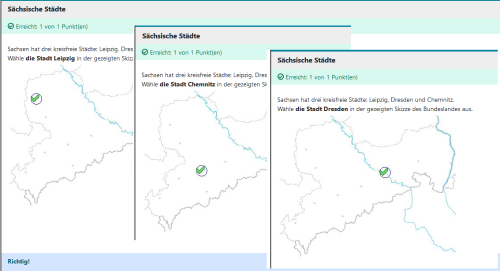Examples
In the following, various application examples for the use of variables are presented. Their implementation will be explained step by step and supplemented with useful information and hints.
Related Topics
Further information
Example "Digging a hole"This sample question shows the use of variables to generate random values in a calculation interaction. The participant should calculate the answer depending on given values, which are redefined for each attempt. |
|
Example "Probability"In the example, a typical question out of probability theory and statistics will be completed. It is to calculate the probability of certain colour combinations, when different coloured spheres are randomly drawn from an urn. |
|
Example "Hypotenuse"In the example, a simple geometric problem will be completed, i. e. the calculation of the hypotenuse: The solution is supposed to be derived from the knowledge that the hypotenuse is the longest side of a right triangle. To do this, the participant is given a variety of possible solutions, from which they need to choose the correct one. The values of the catheti will be randomly chosen from a specified value range for each participant and each test attempt. |
|
Example "Transport" – Use of random parametersThe example shows a typical application question: The goal is to calculate the distance travelled by a vehicle based on speed and time. The speed range will automatically be selected depending on the vehicle type. |
|
Example "Transport" – Adaptive question feedbackAdaptive feedback allows for individual feedback based on the learners' answers. The participant can, for example, be provided with concrete hints or error messages. Post-variables (post-processed variables) will allow access to the learners' responses, e. g. to each gap. Attempts at solutions or even previous answers can also be included in the feedback. |
|
Example "Transport" – Point deduction per attemptIf the participant has several attempts at a solution, individual and successive hints can be provided to help them answer the question. In such scenarios, it may be especially desirable to have points deducted from the participant's total score for each additional attempt. Participants solving the question on the first attempt will receive the full score. The more hints and attempts they need, the lower their score. |
|
Example "Transport" – Assessment of the maximum scoreIf several attempts are possible per question, it might be the case that a participant will not score as many points in a follow-up attempt as were already scored before. If desired, the highest score achieved can be remembered and eventually used for the assessment. The participant should be informed accordingly through notes and shown the score of the current attempt, as well as the maximum score in all previous attempts. |
|
Example "Consider result value signs”For a numerical result value, not only the result value itself, but also the correct sign should be included in the assessment and appropriate individual feedback should be given. |
|
Example "Variable Solution"Correct solutions can also be generated dynamically with the help of variables. This results in flexible task patterns that use random values to create different, equivalent tasks and provide the appropriate solution in each case. |  |







